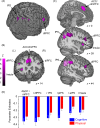Neurocomputational mechanisms underlying subjective valuation of effort costs
- PMID: 28234892
- PMCID: PMC5325181
- DOI: 10.1371/journal.pbio.1002598
Neurocomputational mechanisms underlying subjective valuation of effort costs
Abstract
In everyday life, we have to decide whether it is worth exerting effort to obtain rewards. Effort can be experienced in different domains, with some tasks requiring significant cognitive demand and others being more physically effortful. The motivation to exert effort for reward is highly subjective and varies considerably across the different domains of behaviour. However, very little is known about the computational or neural basis of how different effort costs are subjectively weighed against rewards. Is there a common, domain-general system of brain areas that evaluates all costs and benefits? Here, we used computational modelling and functional magnetic resonance imaging (fMRI) to examine the mechanisms underlying value processing in both the cognitive and physical domains. Participants were trained on two novel tasks that parametrically varied either cognitive or physical effort. During fMRI, participants indicated their preferences between a fixed low-effort/low-reward option and a variable higher-effort/higher-reward offer for each effort domain. Critically, reward devaluation by both cognitive and physical effort was subserved by a common network of areas, including the dorsomedial and dorsolateral prefrontal cortex, the intraparietal sulcus, and the anterior insula. Activity within these domain-general areas also covaried negatively with reward and positively with effort, suggesting an integration of these parameters within these areas. Additionally, the amygdala appeared to play a unique, domain-specific role in processing the value of rewards associated with cognitive effort. These results are the first to reveal the neurocomputational mechanisms underlying subjective cost-benefit valuation across different domains of effort and provide insight into the multidimensional nature of motivation.
Conflict of interest statement
The authors have declared that no competing interests exist.
Figures





References
-
- Robbins T, Everitt B. Neurobehavioural mechanisms of reward and motivation. Current Opinion in Neurobiology. 1996;6:228–36. - PubMed
Publication types
MeSH terms
Grants and funding
LinkOut - more resources
Full Text Sources
Other Literature Sources
Medical

